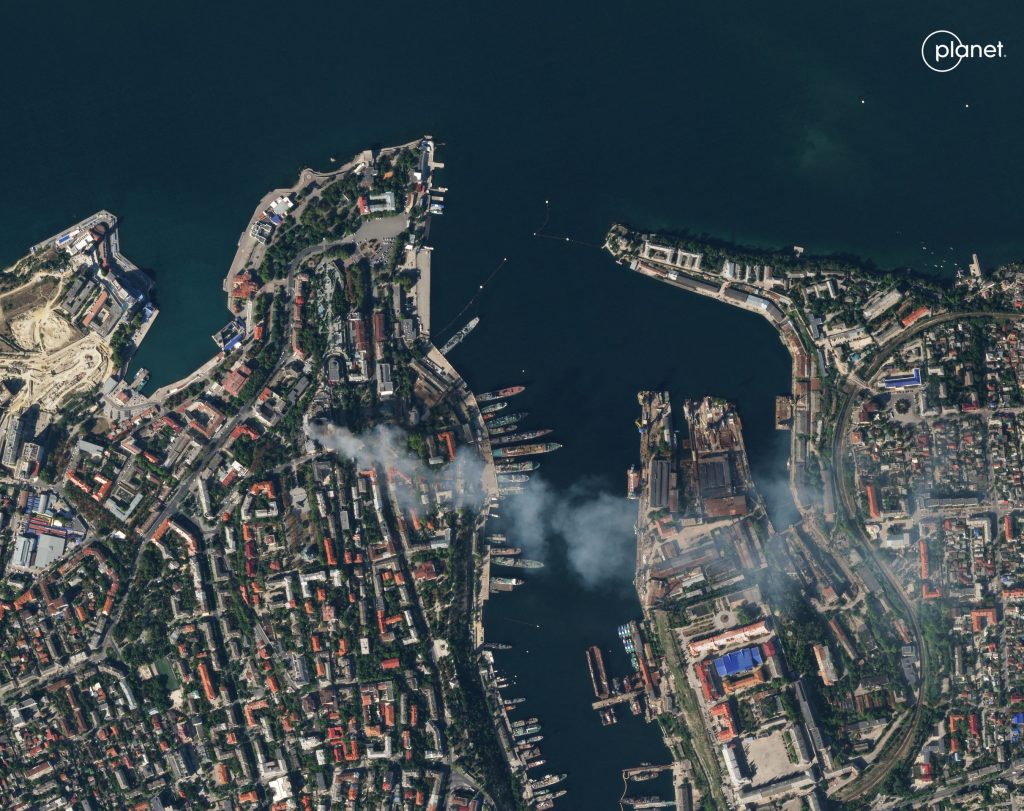Peter Dickinson

Russia has reportedly withdrawn most of its Black Sea Fleet from occupied Crimea in recent weeks following a series of successful Ukrainian attacks. The retreat of the Russian fleet is a serious setback for Vladimir Putin’s ongoing invasion and the latest indication that Ukraine is winning the Battle of the Black Sea.
Satellite footage from early October indicates that Russian vessels including three Kilo-class submarines, two guided missile frigates, and a patrol ship have all been hastily withdrawn from their home port of Sevastopol in Crimea and moved to the Russian port of Novorossiysk on the eastern coast of the Black Sea, according to the Wall Street Journal. Additional Russian warships have been removed from Sevastopol and sent to other ports in the far west of Crimea or elsewhere in the Black Sea.
It is not hard to see why the order was given to pull out of Sevastopol. Since August 2023, Ukraine has carried out a number of audacious attacks that have undermined Russia’s air defenses in Crimea and inflicted serious damage on the fleet itself, with casualties including a number of large warships and a submarine. On September 22, Ukraine was able to bomb and partially destroy the Black Sea Fleet headquarters in the heart of Sevastopol.
Ukraine’s success in the Battle of the Black Sea is all the more remarkable as the country does not currently have a functioning navy. Instead, Ukraine has relied on daring commando raids along with a combination of domestically produced drones and long-range cruise missiles provided by the country’s Western partners. This limited arsenal has been deployed with the kind of ingenuity that has become the calling card of the Ukrainian military.
The first notable breakthrough for the Ukrainian war effort at sea was the April 2022 sinking of the Russian Black Sea Fleet’s flagship, the Moskva. Two months later, Ukrainian forces liberated the small but strategically important Snake Island, which lies close to shipping lanes in the northwestern Black Sea and had been seized by Russia in the early days of the invasion. This was followed by a series of increasingly ambitious drone strikes on Russian military targets across Crimea throughout the second half of 2022 and into the current year.
Ukraine’s Black Sea offensive aims to secure a number of important objectives. By striking Russia’s Black Sea Fleet and sites in Crimea, Kyiv hopes to end the naval blockade of its ports and to disrupt the resupply of Putin’s army in southern Ukraine. Ultimately, the goal is to make the further occupation of Crimea untenable for the Russian military.
The Russian fleet’s withdrawal from Sevastopol underlines the effectiveness of Ukraine’s tactics. This can also be seen in the recent tentative reopening of the country’s Black Sea ports to merchant shipping. Russia first began blockading Ukraine’s ports on the eve of the full-scale invasion, before agreeing to a UN-brokered deal in summer 2022 that enabled limited grain shipments. The Kremlin then withdrew from this grain agreement in July 2023 and threatened to target all cargo vessels sailing to Ukraine.
Undeterred by Russian threats, the Ukrainian authorities declared a new “humanitarian maritime corridor” in early August that runs through Ukrainian waters in the northwestern Black Sea before hugging the coast close to NATO members Romania and Bulgaria. By early October, more than a dozen ships had successfully sailed from Ukrainian ports via the new blockade-breaking route. This maritime traffic represents an economic lifeline for Ukraine that can play a major role in the country’s ability to support itself in a long war.
The dynamic nature of recent developments in the Black Sea is in stark contrast to the relatively static situation on the front lines of the war in southern and eastern Ukraine, where Ukrainian forces have struggled for four months to break through dense minefields and heavily fortified Russian defenses. Since June, Ukraine’s lack of progress has dominated coverage of the war. This media emphasis on large-scale land operations has obscured the wider picture of Ukraine’s considerable success on the Crimean Front. However, news of the Russian fleet’s retreat from Sevastopol may now refocus attention.
Speaking on October 3 at a security conference in Warsaw, UK Minister for the Armed Forces James Heappey argued that the military significance of Ukraine’s recent operations against Russia’s Black Sea Fleet was comparable to the liberation of Kharkiv Oblast one year earlier. “The functional defeat of the Black Sea Fleet, and I would argue that is what it is, because the fleet has been forced to disperse to ports from which it cannot have an effect on Ukraine, is an enormous credit,” commented Heappey in the Polish capital.
Few in Moscow will underestimate the importance of recent setbacks in the Black Sea. On the contrary, they will be well aware of the mounting threat to Crimea and to the Russian army’s operations in the south of Ukraine, not to mention the damage that is being done to Russia’s already battered international prestige. The Russian navy’s retreat from Crimea is a particularly bitter personal humiliation for Vladimir Putin, who began his invasion of Ukraine almost ten years ago with the triumphant February 2014 seizure of the Ukrainian peninsula.
The occupation of Crimea was by far the single most popular event of Putin’s entire reign, sending his approval rating soaring to record highs and setting the stage for the subsequent invasion of mainland Ukraine. This makes the current situation all the more embarrassing. Putin was already struggling to account for his army’s evident inability to conquer a nation that he insists does not exist. He must now also explain how his once vaunted Black Sea Fleet is being defeated by a country without a navy.
No comments:
Post a Comment